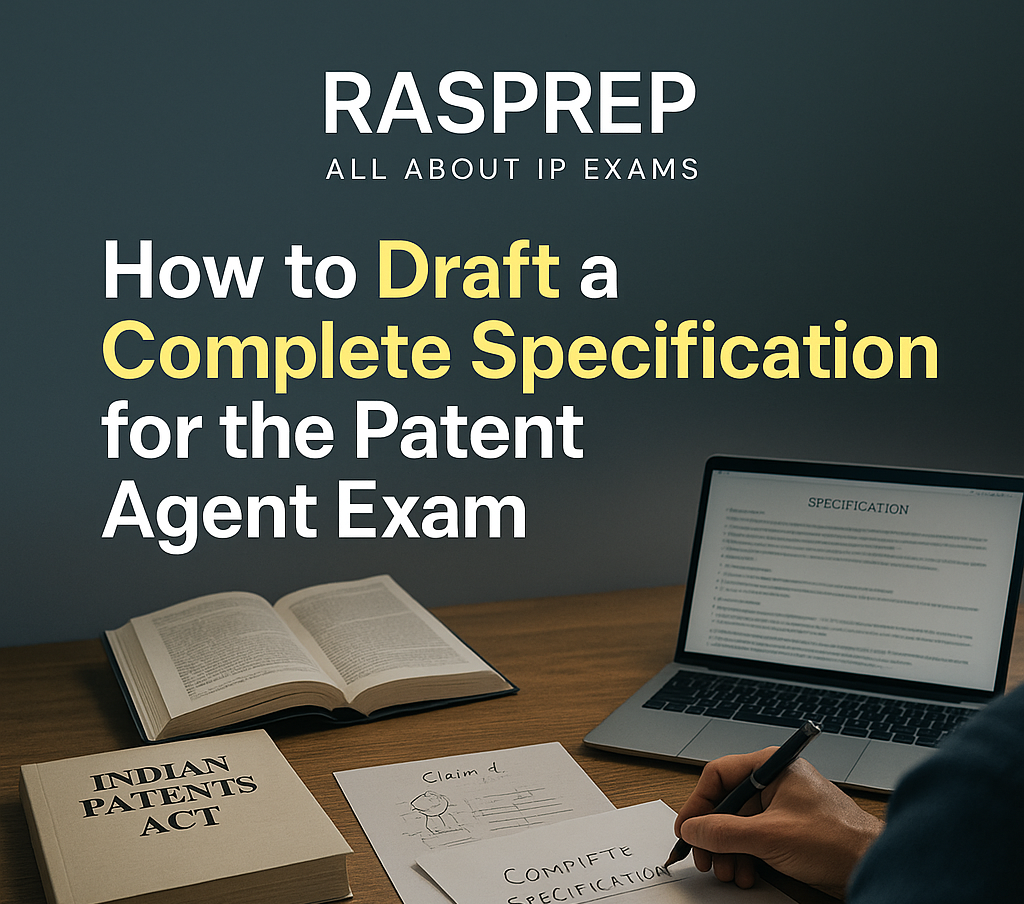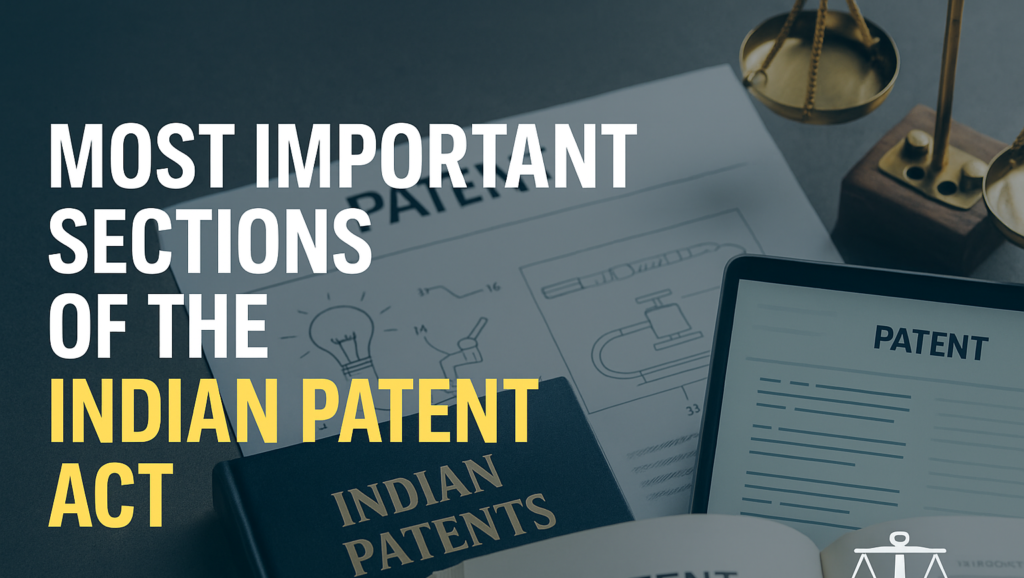Drafting a complete specification is the heart of Paper II. This guide walks you through the essentials of patent writing with real examples, helping you master this skill as part of your patent agent exam preparation strategy.
Feeling Nervous About Drafting a Complete Specification?
If you’re preparing for the Patent Agent Exam, you already know that Paper II is all about writing.
And not just any writing — you must draft something called a Complete Specification.
Many students feel stuck at this part.
- “What do I write?”
- “How do I start?”
- “What if I miss something important?”
If you’re feeling this way, you are not alone.
But don’t worry — with the right method, you can draft like a professional even before you step into the exam hall.
Why Drafting a Complete Specification is Important in Patent Agent Exam
A Complete Specification is the heart of a patent.
It tells the world:
- What your invention is
- How it works
- Why it is different and important
In real life, if you mess up the specification, your patent might get rejected.
In the exam, if you don’t draft properly, you could lose many marks.
In simple words:
Drafting well = Clearing Paper II = Becoming a Patent Agent.
That’s why you must understand it fully — and today, we’ll make it super easy!
What is a Complete Specification? (Simple Explanation)
A Complete Specification is a detailed document that has:
- A full description of the invention
- How it is made and how it works
- What is special or new about it
- Claims that define the protection you are asking for
It’s like telling a detailed story about your invention, step by step, so that anyone skilled in the field can understand and make it.
The 9 Key Parts of a Complete Specification
Here’s the basic structure you need to remember:
| Part | What It Covers |
| Title | Short, clear name of the invention |
| Field of Invention | Which area or subject the invention belongs to |
| Background of Invention | Existing problems; why your invention is needed |
| Summary of Invention | What the invention does in simple words |
| Brief Description | Describe the drawings of the invention briefly |
| Detailed Description | Step-by-step explanation with drawings or diagrams |
| Claims | Legal statements that define the invention’s protection |
| Abstract | Very short summary for easy reference |
| Drawings (if any) | Visual explanation of parts or working |
Each part plays a big role.
Missing any part can mean losing marks — or worse, making the invention unclear.
How to Start Drafting (Step-by-Step)
Many students panic when they see a blank sheet.
Here’s a simple method to start easily.
Step 1: Read the Exam Question Carefully
Usually, the exam gives you an invention idea.
For example:
“A machine that automatically peels and cuts apples.”
First, read the invention idea slowly.
Try to imagine it in your mind.
Step 2: Find the Important Points
Ask yourself:
- What problem does it solve?
- What is the new feature?
- How does it work?
Step 3: Follow the Structure
Now, start filling each section one by one — like filling blanks!
No need to write fancy English. Simple, clear language is best.
Real Example: Drafting for “Automatic Apple Peeling and Cutting Machine”
Let’s do a real mini-example.
Title:
Automatic Apple Peeling and Cutting Machine
Field of Invention:
This invention relates to kitchen appliances, especially machines that peel and cut apples automatically.
Background of Invention:
Peeling and cutting apples by hand takes time and can cause injuries. Existing tools are slow and not fully automatic.
Summary of Invention:
The invention provides a machine that can automatically peel and cut apples using rotating blades and a gripping mechanism.
Brief Description:
The drawings show the machine’s base, apple holder, peeling blades, cutter blade, motor, and start button, along with how they work together to peel and cut the apple.
Detailed Description:
The machine has:
- A base to hold the apple
- A set of rotating blades to peel the apple
- A separate cutter blade to slice the apple
- A motor that powers both peeling and cutting
- A simple button to start the process
The apple is placed in the holder, and once the button is pressed, the machine peels the apple by rotating it and then cuts it into even slices.
Claims:
- A machine comprising a gripping holder, rotating peeling blades, slicing blades, and an electric motor for automatically peeling and cutting apples.
- The machine as claimed in claim 1, wherein a button controls the motor operation.
Abstract:
An automatic apple peeling and cutting machine that uses a motor-driven blade system to peel and slice apples efficiently.
Important Tips While Drafting
- Always keep it simple: No need for complicated words.
- Focus on invention parts: What are the main features?
- Claims are the most important: They decide how strong your patent protection is.
- Drawings help: Even rough sketches make your explanation clearer.
Mistakes You Must Avoid
Here are some common mistakes students make:
| Mistake | How to Avoid |
| Forgetting Claims | Always add at least 2 claims |
| Missing Important Features | List all parts of the invention |
| Using very fancy English | Use simple, clear words |
| Ignoring Background Section | Always explain why your invention matters |
| Writing Abstract too long | Keep it short and sharp |
Remember: The examiner checks if your draft is complete, clear, and logical — not if you use tough words.
Midway Tip: Save this Guide for Revision
When you practice drafting later, come back to this guide.
It’s a ready checklist to make sure you don’t miss any part.
Good drafting is not about speed — it’s about clarity and coverage.
Common Types of Exam Inventions
Here are the types of inventions often given in exams:
| Type of Invention | Examples |
| Simple Machines | Fruit cutter, bottle opener |
| Medical Devices | Thermometer with new features |
| Electrical Gadgets | Smart chargers, battery-operated tools |
| Daily Use Items | Improved chairs, pens, bags |
No matter what invention they give, the structure of drafting stays the same!
Practice Exercise for You
Try drafting a complete specification for this imaginary invention:
Invention Idea: “A solar-powered school bag that charges devices while walking.”
Follow the same 9-part structure. This exercise will boost your confidence massively.
Final Motivation: Drafting is a Skill, Not a Talent
Many students think, “I’m not good at writing, so I can’t draft well.”
That’s not true.
Drafting is a learnable skill — just like riding a bicycle.
The more you practice, the better and faster you will become.
With simple steps, clear structure, and real examples like today,
you can master complete specification drafting confidently.
Conclusion: Your Road to Paper II Success
In the Patent Agent Exam, Paper I tests what you know, Paper II tests what you can do.
By learning how to draft a complete specification today, you are not just preparing for the exam you are building the real skill every patent agent must have.
Stay calm. Write simple. Cover all parts.
You are much closer to success than you think





